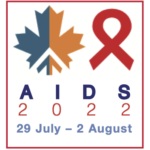VRC01 added to early ART in infants did not reduce viral reservoir
1 September 2022. Related: Conference reports, Paediatric care, World AIDS 24 Montreal 2022.
Polly Clayden, HIV i-Base
 VRC01 made no difference to HIV-1 DNA or RNA when added to early ART in infants compared with ART alone. These results from IMPAACT 2008 – a 60-infant study conducted in Africa and Brazil – were presented at AIDS 2022. [1]
VRC01 made no difference to HIV-1 DNA or RNA when added to early ART in infants compared with ART alone. These results from IMPAACT 2008 – a 60-infant study conducted in Africa and Brazil – were presented at AIDS 2022. [1]
Presenting author Alka Khaitan started the presentation with a reminder that in 2021, more than 160,000 infants acquired HIV.
Rapid formation of latent viral reservoirs is a barrier to ART-free remission. Early ART reduces viral reservoirs in infants. Broadly neutralising antibodies (bNAbs) have the potential to also do so. VRC01 is a bNAb that targets the CD4 binding site of gp120. In the Tatelo Study, dual bNAb treatment maintained 24 weeks of viral suppression without ART in 44% of children who received early ART. [2]
VRC01 combined with early ART in infants may further reduce viral reservoirs.
The objectives of IMPAACT 2008 were to evaluate the safety of multi dose VRC01, given to infants with HIV combined with early ART and to compare the effect of VRC01 with early ART to early ART only on HIV DNA concentrations.
It was a randomised phase 1/2 multisite, open-label study in which infants age 72 hours to 84 days started ART up to 14 days before study entry. Infants were randomised 1:1 to VRC01 plus early ART (VRC01) vs early ART alone (no VCR01). VRC01 was given 40 mg/kg subcutaneous doses at weeks 0, 2, 6 and 10. ART was local standard of care.
Infants were followed for 48 weeks and the primary analysis (presented) was at week 14. Sixty one infants were randomised: 30 in each arm completed week 14 and 28 in each arm completed week 48.
Enrollment was between April 2019 and March 2020 in Malawi, Botswana, Zimbabwe, and Brazil. Infants were 84% black non-Hispanic and 57% female.
Baseline characteristics were (VRC01 vs no VRC01): median age (72 vs 73 days), log10 plasma viral load (4.1 vs 4.4 copies/mL), viral load >100, 000 copies/mL (13 vs 11).
Median days on ART before entry (8 vs 6), receiving nevirapine-based ART (16 vs 9), receiving lopinavir/ritonavir-based ART (14 vs 21), baseline ART resistance (44% vs 33%). ART resistance was mostly to NNRTI.
Ninety per cent of infants experienced local injection reactions (all grade <2). Most resolved within a day and there was no increase with subsequent doses.
Adverse events grade >3 (none attributed to VRC01) to week 14 occurred in 40% of VRC01 and 47% of no VRC01. Most were anaemia, neutropenia and gastrointestinal disorders.
Twenty eight days after VRC01 dose median levels were 83 mcg/mL but 31% of infants had <50 mcg/mL (target). These levels were lower than predicted from earlier studies but no anti-drug antibodies were detected.
Baseline resistance to VRC01 (IC50 >50 mcg/mL) was detected in 5 of 17 (29%) infants with available results receiving VRC01.
Plasma viral load declined in both groups, with no apparent difference at week 14.
HIV DNA changes were measured by droplet digital PCR. In the primary efficacy analysis there was no difference in the decline of HIV DNA at week 14 minus week 0: (VCR01 vs no VCR01) –0.41 vs –0.53 log copies/million PBMCs, p=0.42.
A post hoc analysis revealed higher VCR01 concentrations correlated with larger reductions in HIV DNA: –0.42 (Spearman correlation), p=0.03. Dr Khaitan noted that the limitations of this study included: high baseline NNRTI resistance, more nevirapine in the VRC01 group and small sample size.
She added that more potent ART regimens with combination bNAbs are likely needed to facilitate early clearance of infected cells in infants and that additional studies are required to define how to optimally dose bNAbs.
comment
These results are not unexpected given VRC01 was only given after the viral reservoir was already well established.
It would be interesting to know whether bNAbs are likely to produce different results if used much earlier.
References
- Khaitan A et al. Phase I/II study of monoclonal antibody VRC01 with early antiretroviral therapy to promote clearance of HIV-1 infected cells in infants (IMPAACT 2008).
https://programme.aids2022.org/Abstract/Abstract/?abstractid=12869 (abstract)
https://conference.aids2022.org/media-2104-late-breaker-track-b - Clayden P. Dual bNAb treatment maintains undetectable viral load off-ART in 44% of children in the Tatelo Study. HTB. 1 March 2022.
https://i-base.info/htb/42175

